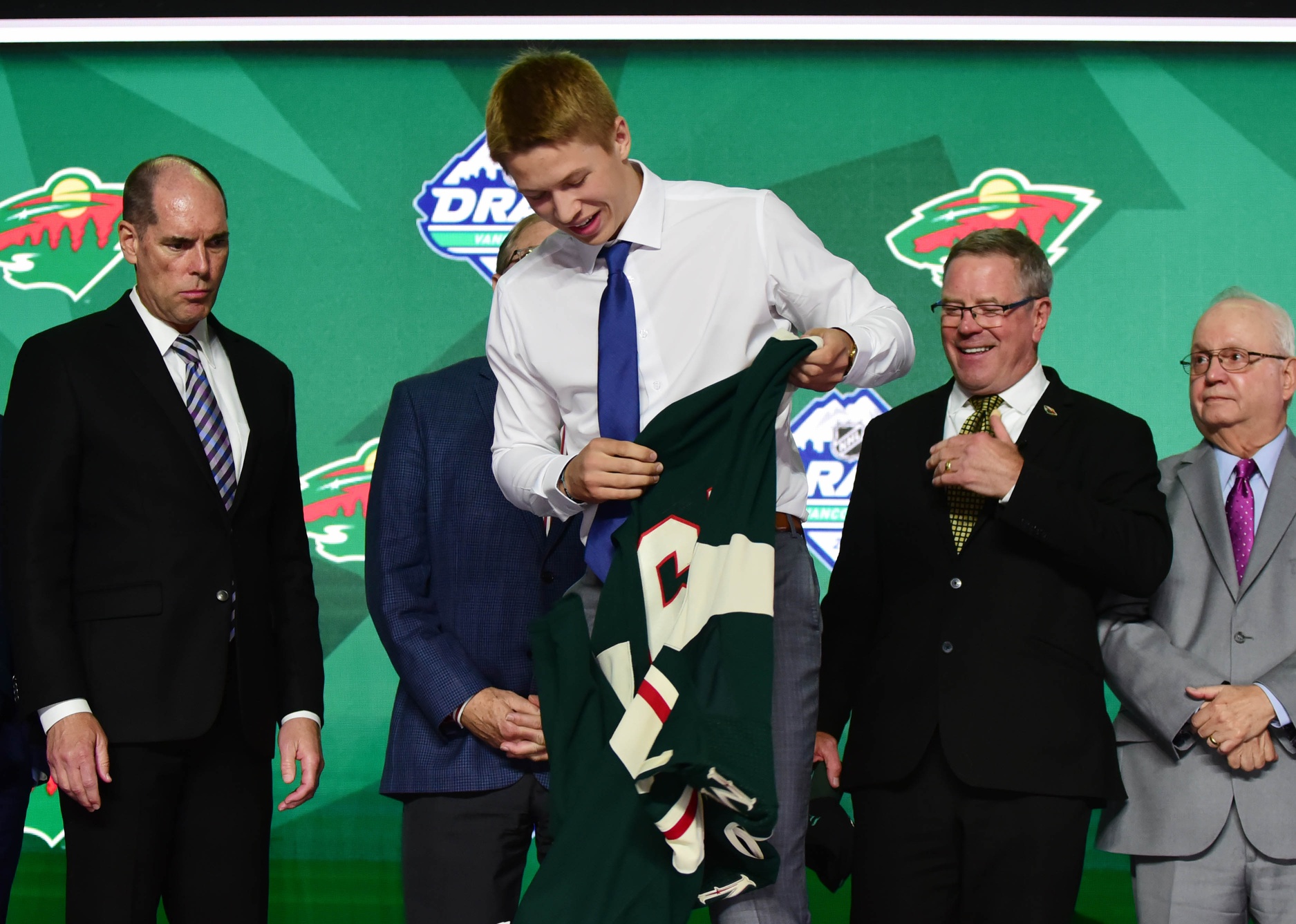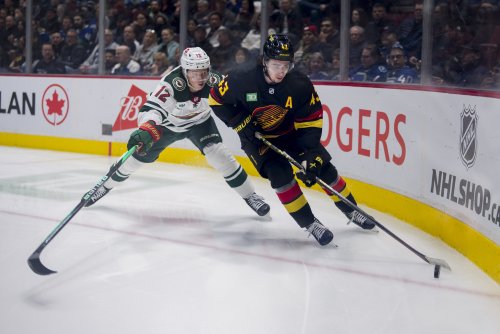
For years, the Minnesota Wild’s prospect pool rested on the laurels of Kirill Kaprizov and not much else. The Wild had just four picks in the 2016 draft, with just one selection out of the first 100, and even that pick yielded only Luke Kunin, a fine but unspectacular NHL player. In 2017, Minnesota didn’t make their first move until 85th overall, almost the fourth round. In 2018, Minnesota drafted Filip Johansson with the 24th pick, which was universally panned at the time.
Now the Wild have a consensus top-10 farm system, perhaps even top-five. What’s remarkable is how quickly and quietly things turned around. Minnesota hasn’t won any draft lotteries, they didn’t bottom out, and they failed to get significant draft capital when tearing down their roster in 2018.
It almost doesn’t make sense, but you’ve got to tip your hat to a combination of P.J. “The Good” Fenton and Judd Brackett for mostly finding players who raised their stocks. The State of Hockey is about to see these prospects come to fruition.
Three of Minnesota’s top prospects — Marco Rossi, Matt Boldy, and Calen Addison — are expected to make their NHL debuts sometime this season. In fact, the Wild might not just be expecting them to arrive in St. Paul; they might be depending on it. Look at the Wild’s depth chart, and you’ll see several holes.
Forwards
Kaprizov - Victor Rask - Mats Zuccarello
??? - Joel Eriksson Ek - Kevin Fiala
Marcus Foligno - Frederick Gaudreau - Jordan Greenway
Nick Bjugstad - Nico Sturm - Ryan Hartman
Defense
Alex Goligoski - Jared Spurgeon
Dmitry Kulikov - ???
There’s a wide-open spot at the wing for Boldy to step into and another at right defense for Addison. Given that Minnesota surely doesn’t want Kaprizov to play with Rask another full season, you can add a third ??? there. Coincidentally, that ??? could also be easily filled by Rossi*.
Since the Wild didn’t make any improvements this offseason, their progress will be largely determined by whether their prospects are ready. These aren’t exactly low-key roles, either. They’ll need to thrive at crucial spots in the lineup. They’ll all have to succeed right away, especially if Minnesota wants to be a more dangerous postseason threat.
It’s a tall order for any rookie to succeed, but all three at once? Granted, there are rookies who pan out every year, but asking three to hit in one season is a lot. Has that even been done?
Luckily for Minnesota, there is precedent for this type of rookie crop excelling from a point production standpoint. Since the 2004-05 lockout, six teams have had three or more rookies with 40-plus games while scoring at least 0.5 points per game.
The kings of the field are the 2005-06 Pittsburgh Penguins, who actually had four rookies meet that criteria. Sidney Crosby is the headliner, with defenseman Ryan Whitney and forwards Colby Armstrong and Michel Ouellet backing up Sid the Kid.
They weren’t the only team that year to have a bunch of rookies hit. The Anaheim Ducks had 20-year-old center Ryan Getzlaf put up 39 points in 57 games despite getting just 12:35 of ice time per night. Chris Kunitz and Francois Beauchemin also achieved that points threshold as rookies.
The next season, the San Jose Sharks got into the outstanding rookie game. Joe Pavelski, Matt Carle, and Ryane Clowe all made their full-time NHL debuts and ran with them. All three showed that they could be plugged into that Sharks power-play machine right away.
As the post-lockout offensive boom slowed, so too did these impactful rookie crops. We wouldn’t see another until 2010-11 when the Edmonton Oilers debuted Taylor Hall, Jordan Eberle, and Linus Omark. Then it was another long wait until 2016-17, when Auston Matthews, Mitch Marner, and William Nylander made rookie splashes with the Toronto Maple Leafs. The next year, the Boston Bruins had rookies Charlie McAvoy, Jake DeBrusk, and Danton Heinen hit those marks.
And that’s it for the past 15 years. Think of all the most successful youth movements — the Chicago Blackhawks, the Washington Capitals, the Los Angeles Kings, the Tampa Bay Lightning. The core young members of those teams all trickled in over a few years.
What those six teams with three impactful rookies did is a rare occurrence, even among model franchises. It gets even rarer when you factor age into the equation. Addison is the oldest of the Wild’s three likely rookies at 21. How many teams have churned out three under-22 rookies with 40-plus games and 0.5 points per game since the lockout? Just those 2016-17 Maple Leafs. In fact, only 12 teams have had even two such rookies hit in the same year.
What made that crop of Leafs rookies so successful? Part of it was that the organization showed patience (or a willingness to tank) and avoided calling up Nylander or Marner to win meaningless games in 2015-16. They also all got a lot of trust from coaches, with each playing 16-plus minutes per night.
But the biggest reason was that they were all freakish talents who were basically locks to succeed. According to Hockey Prospecting’s model, Matthews had a 99% chance of becoming a star the moment he was drafted. By the time they made the NHL, Nylander and Marner’s odds of stardom were 94% and 69%, respectively.
Minnesota’s rookie crop is great, but it doesn’t quite compare. Marco Rossi rates highest on Hockey Prospecting’s model with an 82% chance of becoming a star, with Addison and Boldy at 53% and 49%, respectively. So, health permitting, Rossi should hit stardom while Addison and Boldy are coin flips to reach that level. That’s fantastic — the best position the Wild have ever been in — but it’s not quite where those Leafs were.
That’s not to write anyone off. There’s a decent chance Minnesota could hit on all three of those prospects. In the short term, though, it’s wise to temper expectations. They’re still developing. It’s very encouraging that both Addison and Boldy jumped up to the AHL level without missing a beat, but the NHL is a different beast altogether. Rossi is working his way back from myocarditis, and while he says he feels stronger and better, he’ll have gone 18 months with playing only a handful of international games.
Minnesota’s prospect pool came together almost miraculously quickly. It’s easy to think that trajectory will carry over to the NHL. And, hey, we don’t know, maybe that will happen, but the safe bet is to assume that the NHL development of this crop of prospects will be staggered. If this year fails to yield three or even two star rookies for Minnesota, just know that it’s not a disappointment. It’s normal.
All data is from Stathead.com unless otherwise stated.
*An earlier version of this article stated that Boldy could fill in for Rask. We regret the error.
Think you could write a story like this? Hockey Wilderness wants you to develop your voice, find an audience, and we'll pay you to do it. Just fill out this form.








Recommended Comments
There are no comments to display.
Join the conversation
You can post now and register later. If you have an account, sign in now to post with your account.
Note: Your post will require moderator approval before it will be visible.